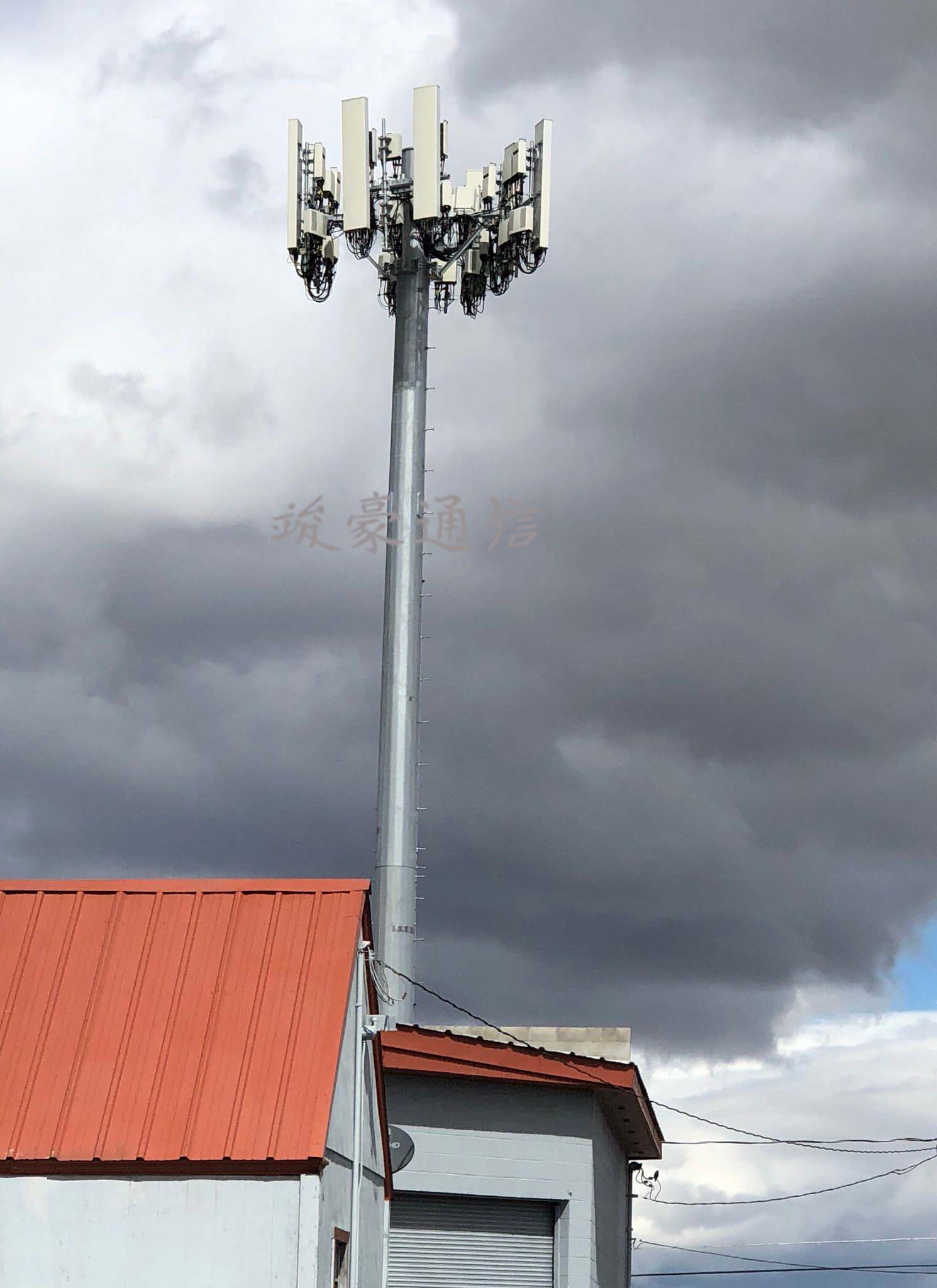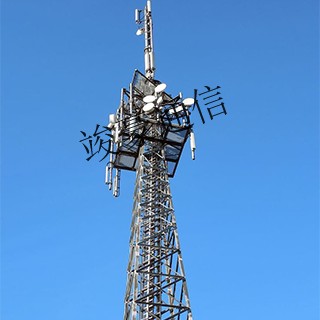Exploring Unipolar Towers: The 'Super Raiders' in the Field of Power Transmission
What is the sanctity of the unipolar tower?

Among various transmission and communication facilities, single pole towers are gradually emerging. A monopolar tower, from its appearance, usually has simple and smooth lines, mostly regular polygonal cross-sections, such as the common hexagonal curved cross-section. From the bottom to the top of the tower, it presents a unique shape that changes from large to small, like a agile giant gradually extending into the sky. This linear design not only gives a sense of firmness and resilience visually, but also makes the monopolar tower appear more simple and elegant compared to some complex tower structures.
Its figure often appears on the outskirts of cities, in the wilderness of the suburbs, or on cross sea routes. In the city, single pole towers stand silently, shouldering the responsibility of transmitting electricity and ensuring the brilliance of thousands of lights; In the wild, it crosses mountains, rivers, and builds communication bridges, allowing information to be transmitted rapidly. Like the 275 kV cross sea transmission line project in Penang, Malaysia, which includes 25 single pole towers, they serve as a landscape and landmark project next to a bridge in Penang, injecting strong momentum into local development, solving the future electricity demand of Penang Island, and also becoming a unique scenic spot in the area.
一、Structural advantage: a perfect combination of stability and efficiency

(一) Unique design, stable foundation
The single pole tower has a unique structural design, and the regular hexagonal curved section is not arbitrary. Compared to the traditional quadrilateral section, the hexagonal section can more evenly distribute the force. Imagine when a strong wind howls past, the wind force acting on the tower is cleverly dissipated by the sides of the hexagon, like a stable hexagonal shield, greatly enhancing the ability of the monopolar tower to resist lateral wind, allowing it to stand firm in the strong wind. Moreover, the design of gradually decreasing from large to small from the bottom to the top of the tower is exquisite and unparalleled. This gradient structure makes the center of gravity of the tower more stable. The wide foundation at the bottom is like the feet of a giant, firmly rooted in the ground and carrying the weight of the entire tower. The gradually decreasing upper part reduces high-altitude wind resistance, further enhancing the overall stability, ensuring that the single pole tower can hold its position and ensure the safe operation of the line under various complex and harsh weather conditions.
(二) Simple design, easy to maintain
The monopolar tower does not have too many complex structures or redundant components, its lines are simple and smooth, and its internal structure is clear and distinct. This design makes daily maintenance work much easier, and staff do not need to shuttle between complex components to quickly locate and repair areas that may have problems. Compared with those iron towers with complex structures and numerous components, single pole towers save a lot of time and labor costs during maintenance. For example, during line inspections, staff can climb single pole towers more conveniently to inspect key parts such as tower bodies and line connection points. Once problems such as loose bolts or damaged insulators are found, they can be quickly dealt with, greatly improving maintenance efficiency, reducing power outages caused by equipment failures, and ensuring the continuity of power supply.
二、Adaptation scenario: "All rounder" in complex environments

(一) A friendly choice for urban space
In the current era of booming urban construction, land resources are becoming increasingly precious, highlighting the advantage of single pole towers occupying a small area. Compared with traditional iron towers that occupy a larger area, a single pole tower is like a "slender" guardian, capable of stably carrying lines with a smaller footprint. Taking the common urban substation supporting transmission lines as an example, traditional iron towers may require a large open space for installation, while single pole towers, with their compact structure, can easily adapt to narrow spaces such as street corners and green belts, freeing up valuable land for other construction projects in the city. Moreover, the simple and smooth appearance design of the single pole tower is more modern and aesthetically pleasing compared to some complex and slightly bulky iron towers. It can better integrate into the urban landscape without giving a sense of abruptness, meeting people's pursuit of urban environmental aesthetics and becoming the preferred choice for power transmission and communication facilities in urban development.
(二) A powerful tool for dealing with special terrains
In some special terrain areas, monopolar towers demonstrate extraordinary adaptability. Taking the mining affected area as an example, when underground resources such as coal mines are mined, problems such as subsidence and collapse may occur on the ground, which poses a huge challenge to the towers of transmission lines. The traditional method of double pole installation on the same tower, due to the presence of torque between the two poles, can cause uneven settlement of the tower base, making the tower prone to distortion, deformation, and even collapse, posing a serious threat to the safety of the transmission line. The single pole tower can cleverly solve this problem. It can split the double pole installation of the DC line on the same tower into two single poles for operation, eliminating the torque effect of broken wires and uneven ice, and avoiding tower damage caused by excessive torque and torsional deformation. The transmission line project in a mining affected area in Shanxi Province has effectively resisted the uneven settlement of the lower soil by using single pole towers and installing protective plates. The displacement of the transmission tower supports and the stress of the upper structure have been greatly reduced, ensuring the safe and stable operation of the line under complex geological conditions and safeguarding the local energy transmission and economic development.
三、Economic considerations: Excellent embodiment of cost-effectiveness

(一) Careful calculation of material usage
In terms of material usage, the single pole tower demonstrates its energy-saving nature. Compared to other tower types with the same height and load requirements, such as some twin tower structures, single pole towers, due to their unique structural design, are more directly and efficiently subjected to forces, without the need for additional reinforcement components to balance complex forces. Taking the common transmission tower with a height of 50 meters, bearing a certain wind pressure and wire load as an example, the traditional twin tower structure may require a large amount of angle steel, connectors, etc., with a steel consumption of about 15 tons. However, the single pole tower, with its stable hexagonal cross-section and gradual structure, can reasonably distribute stress, so that the steel consumption can be controlled within 10 tons, saving about one-third of the steel and greatly reducing raw material costs. This undoubtedly saves a considerable amount of expenses for large-scale transmission and communication line construction.
(二) Cost control of construction and operation
The construction and installation process of a single pole tower is relatively simple and fast, which can effectively shorten the construction period and reduce labor costs. Its simple structure makes it more convenient for workers to operate during on-site assembly, without spending a lot of time on complex component splicing and calibration. For example, in a transmission line renovation project in a certain city, the construction of single pole towers was adopted, which shortened the construction time by nearly one-third and reduced labor costs by about 40% compared to the traditional iron towers previously used. And in terms of later operation and maintenance, the advantages of single pole towers are also prominent. Due to its simple structure and few components, the probability of failure is relatively low, resulting in a significant reduction in the workload of daily inspections and maintenance. Once a problem occurs, the time and material costs required for maintenance are much lower than those of complex structure iron towers. In the long run, it saves a lot of operation and maintenance funds for the operating unit, effectively controlling the full life cycle cost of the line.
四、Technological innovation: the culmination of cutting-edge technology

(一) Upgraded power transmission technology
Monopolar towers are constantly innovating in transmission technology, greatly improving transmission efficiency and reducing energy losses. In the selection and arrangement of wires, a new type of high-strength, low resistance wire is used. Compared with traditional wires, its resistivity is significantly reduced, which can effectively reduce heat loss during current transmission. For example, a new type of aluminum alloy composite wire has a resistivity reduced by about 15% compared to ordinary steel core aluminum stranded wire. It can significantly reduce the unnecessary consumption of electrical energy on the wire during long-distance transmission, allowing more electrical energy to be accurately delivered to the user end. Moreover, the optimization of the internal structure of the single pole tower provides a more reasonable space for the layout of wires, further reducing electromagnetic interference between wires, ensuring the stability of power transmission, improving the quality of power transmission, and laying a solid foundation for efficiently meeting modern power demands.
(二) Seamless integration of intelligent monitoring
Today's monopolar tower is like a guardian with a "smart brain", equipped with advanced intelligent monitoring systems. By installing various high-precision sensors at key parts of the tower, such as strain sensors, tilt sensors, wind speed sensors, etc., a single pole tower can sense its structural status and changes in the surrounding environment in real time. These sensors are like sharp antennae, collecting data 24 hours a day without interruption and quickly transmitting the data back to the monitoring center through wireless transmission technology. Once the tower body tilts slightly, the foundation settles, or encounters strong winds and other abnormal situations, the monitoring center can immediately receive warning information. The operation and maintenance personnel can respond in a timely manner, take measures such as reinforcing the tower base, adjusting the tension of the wires, etc., nip potential risks in the bud, comprehensively ensure the safe and stable operation of the transmission line, and make a qualitative leap in the reliability of power supply.
Single pole tower, lighting up the light of future electricity

Single pole towers shine brightly in today's power transmission and communication fields due to their stable and efficient structure, wide adaptability to various scenarios, excellent economic cost-effectiveness, and cutting-edge technological innovation. It is like a brilliant pearl, injecting strong impetus into the vigorous development of the power industry. With the continuous progress and innovation of technology, we believe that the monopole tower will continue to evolve and upgrade, further optimize its structure, expand its application scenarios, reduce costs, and integrate more cutting-edge technologies. This will lay a more solid foundation for ensuring global energy supply, promoting high-speed information transmission, and helping society move towards an intelligent future. We will continue to write our own brilliant chapter and spread light and convenience to every corner of the world.




